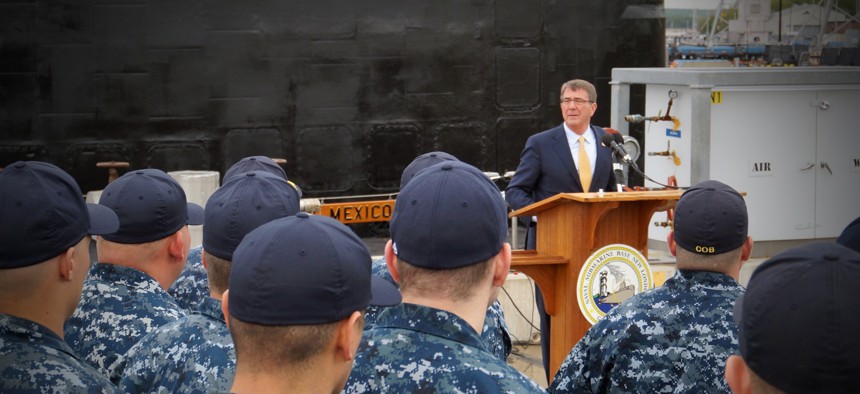
Defense Secretary Ash Carter speaks to sailors at Sub Base New London, Connecticut, on May 24, 2016. (Bradley Peniston / Defense One)
Pentagon Playing the Long Game in the South China Sea, Carter Says
For China, like the old Soviet Union, the U.S. defense secretary bets “internal logic” will dictate a change—eventually.
NEWPORT, R.I. — The U.S. military’s effort to keep the Asia-Pacific region stable and secure in the face of a rising China is akin to the 50-year Cold War standoff with the Soviet Union, Defense Secretary Ash Carter said Wednesday. Chinese and U.S. actions and reactions in the South China Sea are just one part of a grand pattern in an era he predicted will end when China changes internally.
It’s “going to be a long campaign of firmness, and gentle but strong pushback for probably quite a number of years,” Carter told sailors at the Naval War College on Wednesday. “Our Asia rebalance isn’t ‘try it out for a little while.’ It’s a long-term kind of thing.”
“The internal logic” of China and its society will eventually dictate a change, “but that’s almost academic at this point because their leadership is way on the other side of that equation right now,” he said.
Recent headlines about U.S. aircraft and warships passing through the South China Sea — where China has been creating islands from dredged sand, then building military-grade runways on them — are only the most visible piece of a larger plan, Carter said earlier in the week.
“The rebalance is a lot more than freedom-of-navigation operations,” he said after addressing sailors at Sub Base New London in Connecticut. “It’s a whole program of enhanced activities in the Asia-Pacific — by the way, diplomatic and economic as well as military.”
Related: Carter: Wider US-Vietnam Military Relations Not ‘Directed’ at China
Related: Top Admiral Asks US Allies to Help Buzz China’s Fake Islands
Related: Beijing Is Setting the Stage for War in the South China Sea
Related: How to Turn The Heat Down in the South China Sea
“It is shifting forces to that part of the world, it is modernizing forces in that part of the world, it is the enormous pattern of bilateral and multilateral exercising we do, partnerships with the militaries in the region who are very eager to work increasingly with the United States,” he said. “It’s a whole lot of things that are intended to keep the system of peace and stability in the Asia-Pacific that served the region so well for so long.”
As for freedom-of-navigation operations — the U.S. has sent three warships sailing close by China-claimed areas since October, and flown aircraft nearby as well — those aren’t just about the South China Sea, Carter said.
“That’s something we do worldwide. It’s not just about any one country, including China,” he said. “There are other claims in the South China Sea, and we challenge those claims as well.”
Such claims ought to be settled in a peaceful way, not by militarizing them, not by coercion, Carter said.
“That’s a principle we stand for all over the world, and it’s important all over the world, from the South China Sea to the Arctic,” he said, where Russia and other countries have been advancing new claims. “The United States has been, and other countries have been standing up for this for a couple hundred years.”
